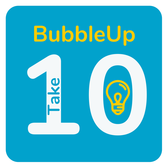 The beginning of the school year always has me excited for change. Classroom teachers may have the opportunity to transform their classroom space as they set up each year, but often, our libraries stay very much the same. This Take5 has some quick ideas on how to transform your library space without spending too much time or money. And, perhaps it will offer inspiration to some classroom teachers as well. How can you change up your space to keep student learning focused and your own teaching fresh and engaging?
0 Comments
 Librarian Lara Ivey is an inspiring, energetic force. Just four years into her library career, she won the James Regional Librarian of the Year Award for 2018 from the Virginia Association of School Librarians (VAASL) and serves as a leader on projects for both VAASL and the national organization, the American Association of School Librarians. We are excited to share a bit of her story in this week's BubbleUp Take10.  In last week's post Gretchen shared ideas about how to help foster reading at home. The experience in my home dovetails nicely with her focus on reading. My kid loves to read, but math is not her thing. She's good at it, but she'd rather spend time writing stories or reading. I was the same way. That doesn't bother me or really concern me as a parent. What is troublesome is the negative talk that has crept slowly into our home. She declares "I hate math" or "I'm not good at math." I've done all the things the experts have told me to do: Talk about how much I love math. Focus on finding math in every day life (I could do better at that). Talk about how I'm good at math and she's good at math. But it isn't working. So I've done a dive into ideas for help. So here's a Take 5 with a math focus for teachers and parents alike. It's messy. Just as with real math, there is not just one method to answer the problem; but the more you know, hopefully the more you can help your own kid or the kids in your classroom.  My oldest son started reading early -- he was into chapter books before he started kindergarten. Reading came easily to him and is still, at 13, his favorite pastime. I assumed the same would hold true for my younger son. But as all parents quickly learn, each child is different. When reading hadn’t stuck by second grade, I hit the panic button -- met with teachers, studied articles on phonetics instruction, went through some testing, all the while reminding myself of the whole “each child is different” thing... I can comfortably say that now, entering fourth grade, my youngest child is a reader. He had support from fantastic teachers in second and third grade, but I also believe that as a librarian and a mom, what happens at home matters a whole lot too in terms of a child’s reading development. Here are some strategies I have discovered and rediscovered on my parenting journey. I hope they will help you continue to kindle a love of reading in your own home or even better, if you are an educator perhaps these strategies can be shared with your students' parents as a way of helping them foster a love of reading at home. |
Who We Are
Join our list!Archives
September 2020
Categories
All
|






 RSS Feed
RSS Feed